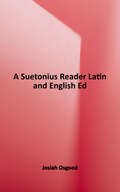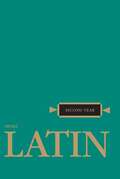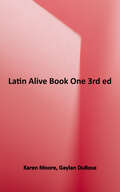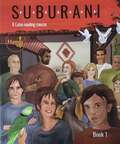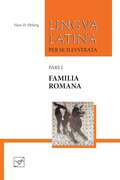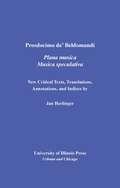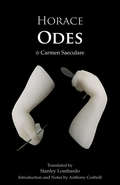- Table View
- List View
Caesar: Selections From His Commentarii De Bello Gallico
by Hans-Friedrich Mueller Julius Caesar Donald E. Sprague Bridget S. DeanNIMAC-sourced textbook
Cicero: Pro Archia Poeta Oratio (Annotated Latin Collection)
by Steven M. Cerutti Cicero Gaby HuebnerNIMAC-sourced textbook
Ovid: Amores, Metamorphoses Selection
by Charbra Adams Jestin Phyllis B. Katz Ovid Bridget Dean Laurie Haight Keenan Laurel DraperNIMAC-sourced textbook
Vergil's Aeneid: Selected Readings From Books 1, 2, 4, And 6
by Barbara Weiden Boyd Vergil Bridget Buchholz D. Scott Van HornNIMAC-sourced textbook
A Suetonius Reader: Selections From the Lives of the Caesars and the Life of Horace
by Josiah OsgoodThe popular appeal of Suetonius' Lives of the Caesars is obvious. Who would not thrill reading about the great Julius Caesar's delight in the Senates bestowal of the right to wear a laurel wreath on all occasions because it covered his baldness? Or that the Divine Augustus had rotten teeth and wore special platform shoes to make himself look taller? <p><p>Suetonius, however, has not always been as enthusiastically received among historians, who sometimes overlook that he intended his work as biography, not history, or that he patently aimed for prose that was not literary, but instead unadorned, clear, and concise. Such qualities of prose, however, happily make his Latin enjoyable both to teach and to read. And while Suetonius' details of the weird worlds of extraordinary men are endlessly entertaining, they are not merely that. This business like biographer produced an extraordinarily influential work. His Caesars is a landmark in the history of biographical writing, and remains a key source for the history of Rome, its transition from Republic to Empire, and contemporary efforts to come to terms with individual destiny, through astrology, physiognomy, dream analysis, and more. Through to the present day Suetonius has profoundly shaped modern perceptions of Roman society.
Second Year Latin
by Robert J. HenleThe backbone of Henle Latin Second Year is intensive language study, including review of the first year plus new materials. Separated into four parts, Henle Latin Second Year includes readings from Caesar's Commentaries, extensive exercises, and Latin-English vocabularies. Humanistic insight and linguistic training are the goals of the Henle Latin Series from Loyola Press, an integrated four-year Latin course. Time-tested and teacher endorsed, this comprehensive program is designed to lead the student systematcially through the fundamentals of the language itself and on to an appreciation of selected classic texts.
Latin Alive! (Latin Alive Series #Book One)
by Karen Moore Gaylan DuBoseStudents will be delighted by what they learn in each new chapter of Latin Alive!, Book One, and they will learn to see that Latin is everywhere around them. As the first text in a three-year series, it is a rigorous and thorough introduction to this great language and is designed to engage upper school (middle and high school) student. Brimming with relevant facts and stories this text offers something for everyone. A Teacher’s Edition including answer keys, teacher’s helps and additional activities is available separately.
Suburani
by Hands Up EducationExcerpt from the back cover: "It's the spring of AD 64 and, as dawn breaks over the Subura in Rome, a young woman calls from high in an apartment building to her aunt working in a bar below. While her father collects the rent from the other tenants, a falling tile narrowly misses a senator's son passing through the streets in a litter. Was it an accident? In the Subura, your life hangs by a thread.
Familia Romana (Lingua Latina #Book One)
by Hans H. ØrbergHans Ørberg's Lingua Latina per se Illustrata is the world's premiere series for learning Latin via the Natural Method. The Natural Method encourages students to learn Latin without resorting to translation, but instead by teaching them to think in the language: students first learn grammar and vocabulary inductively through extended contextual reading and an ingenious system of marginal notes. Lingua Latina per se Illustrata is also the most popular series for those teachers at both the secondary and collegiate levels who wish to develop Latin conversational skills in the classroom. <p><p>Familia Romana (the main book of Pars I of the Lingua Latina per se illustrata series) contains thirty-five chapters and describes the life of a Roman family in the 2nd century A.D. It culminates in readings from classical poets and Donatus's Ars Grammatica, the standard Latin school text for a millennium. Each chapter is divided into two or three lessons (lectiones) of a few pages each followed by a grammar section (Grammatica Latina) and three exercises (Pensa). Hans Ørberg's impeccable Latin, humorous stories, and the Peer Lauritzen illustrations, reproduced in full color, make this work a classic. The book also includes a table of declensions, a Roman calendar, and a word index (index vocabulorum). <p><p>The Lingua Latina series incorporates the following features: <p><p>The most comprehensive treatment of Latin grammar available in an elementary textbook. <p><p>A vocabulary of almost 1,800 words, reinforced by constant and creatively phrased repetition, vastly expands the potential for later sight reading. <p><p>A complete line of ancillary volumes, exercises, and readers both in print and online.
Prosdocimo de' Beldomandi's Musica Plana and Musica Speculativa (Studies in the History of Music Theory and Literature)
by Prosdocimo de' BeldomandiAvailable in English for the first time, Prosdocimo's Tractatus plane musice (1412) and Tractatus musice speculative (1425) are exemplary texts for understanding the high sophistication of music theory in the early fifteenth century. Known for considering music as a science based on demonstrable mathematical principles, Prosdocimo praises Marchetto for his theory of plainchant but criticizes his influential Lucidarium for its heterodox mathematics. In dismissing Marchetto as a “mere performer,” Prosdocimo takes up matters as broad as the nature and definition of music and as precise as counterpoint, tuning, and ecclesiastical modes. The treatises also reveal much about Prosdocimo’s understanding of plainchant; his work with Euclid's Elementa; and his familiarity with the music theory of Boethius, Macrobius, and Johannes de Muris. A foremost authority on Italian music theory of the Middle Ages and early Renaissance, Jan Herlinger consults manuscripts from Bologna, Cremona, and Lucca in preparing these valuable first critical editions.
Odes: With Carmen Saeculare
by HoraceHorace's Odes enjoys a long tradition of translation into English, most famously in versions that seek to replicate the quantitative rhythms of the Latin verse in rhymed quatrains. Stanley Lombardo, one of our preeminent translators of classical literature, now gives us a Horace for our own day that focuses on the dynamics, sense, and tone of the Odes, while still respecting its architectonic qualities.In addition to notes on each of the odes, Anthony Corbeill offers an Introduction that sketches the poet's tumultuous political and literary careers, highlights the Odes' intricate construction and thematic breadth, and identifies some qualities of this work that shed light on a disputed question in its reception: Are these poems or lyrics?This dual-language edition will prove a boon to students of classical civilization, Roman literature, and lovers of one of the great masters of Latin verse. The Amazon Kindle and other flowing-text eBook editions include the text of the Latin originals at the end of the book and the line numbers are enclosed in square brackets and embedded at the end of lines.

